“HEY, wanna go meet the Mayor of El Mirage?”
My face twists in confusion. “Who?”
“This guy George. He’s not really the mayor, but whatever. C’mon, let’s go, I promise there’s some cool shit.”
I’m with Adam Rogers, long-time land speed racer and tech inspector for the Southern California Timing Association and Bonneville Nationals Inc. Somewhat reluctantly, I hop in the car with him and we bump and rattle our way past the lake bed, down some sand roads and pull up at a mostly torn-down fence. As I clumsily climb over it, I’m even more reluctant to be here; my eyes are pinned to the ‘Protected By Guard Dogs’ sign with a bullet hole in it.
 We’re greeted by a missile-shaped object with the word EXPERIMENTAL stencilled below what looks to have been the cockpit. Behind it sits a stripped turbine engine and some kind of long, finned vehicle; I’m wondering if somehow they’re all related.
We’re greeted by a missile-shaped object with the word EXPERIMENTAL stencilled below what looks to have been the cockpit. Behind it sits a stripped turbine engine and some kind of long, finned vehicle; I’m wondering if somehow they’re all related.
 We walk up to a second fence and as the landscape unfolds I find myself in something reminiscent of a scene from Mad Max. Pieces of dismantled theme-park rides are strewn across the sand, resting against the cobweb-covered skeletons of once-running American classics.
We walk up to a second fence and as the landscape unfolds I find myself in something reminiscent of a scene from Mad Max. Pieces of dismantled theme-park rides are strewn across the sand, resting against the cobweb-covered skeletons of once-running American classics.
 “George!”
“George!”
I’m snapped out of gazing at a Ferrari 250 body hidden under some wood fencing.
“Hmmm, don’t think he’s home,” Adam says. “It’s all right, he’s an old buddy of mine; we can go look around.”
As we walk through aisles of dormant tin, Adam points out all kinds of things, telling stories or helping me identify what these bits of twisted metal formerly were.
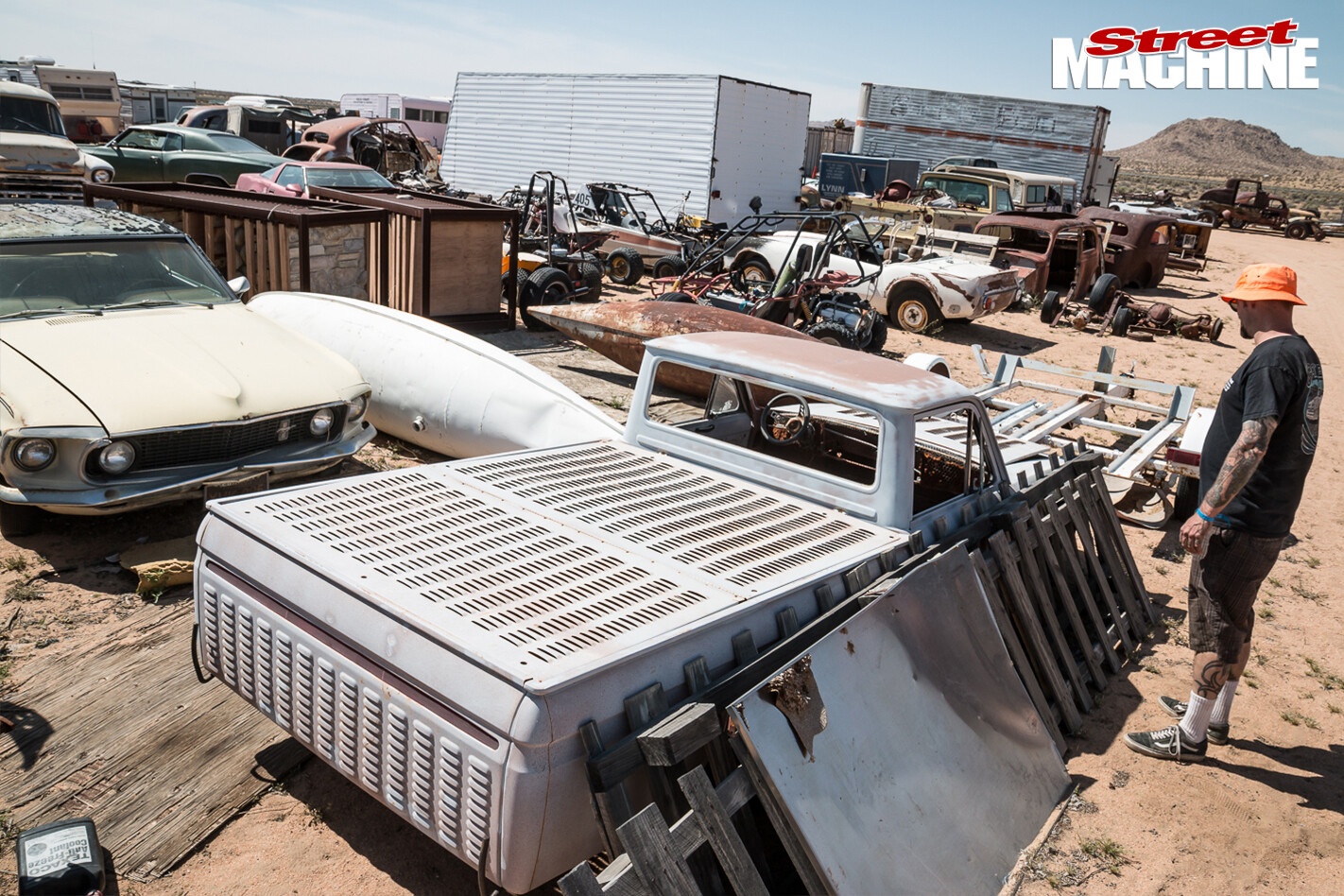 He explains this place belongs to George Callaway, an aeronautical engineer who’s built Lockheed fighter jets, and also worked with NASA building space shuttle engines and on the Apollo project. He’s been a land speed racer since the 40s, and his competition coupe was the first ever to break 200mph at Bonneville. He’s also worked with TV Tommy Ivo, Walt Arfons’s Bonneville legend Wingfoot Express, and even a Pontiac factory race team. These days he looks after a lot of the SCTA stuff for racing at El Mirage Lake and has become something of a custodian of it – hence his unofficial ‘mayor’ moniker.
He explains this place belongs to George Callaway, an aeronautical engineer who’s built Lockheed fighter jets, and also worked with NASA building space shuttle engines and on the Apollo project. He’s been a land speed racer since the 40s, and his competition coupe was the first ever to break 200mph at Bonneville. He’s also worked with TV Tommy Ivo, Walt Arfons’s Bonneville legend Wingfoot Express, and even a Pontiac factory race team. These days he looks after a lot of the SCTA stuff for racing at El Mirage Lake and has become something of a custodian of it – hence his unofficial ‘mayor’ moniker.
 The property is full to the brim with machinery that would give the War Boys a run for their money. A jacked-up Morris monster truck lies a few paces from a truck chassis stacked full of Ferris wheel seats. Warplane bellytanks and turbines sit amongst the bodies of pre-war coupes, strange European sedans, and there’s even a Mercury Capri in pretty decent condition.
The property is full to the brim with machinery that would give the War Boys a run for their money. A jacked-up Morris monster truck lies a few paces from a truck chassis stacked full of Ferris wheel seats. Warplane bellytanks and turbines sit amongst the bodies of pre-war coupes, strange European sedans, and there’s even a Mercury Capri in pretty decent condition.
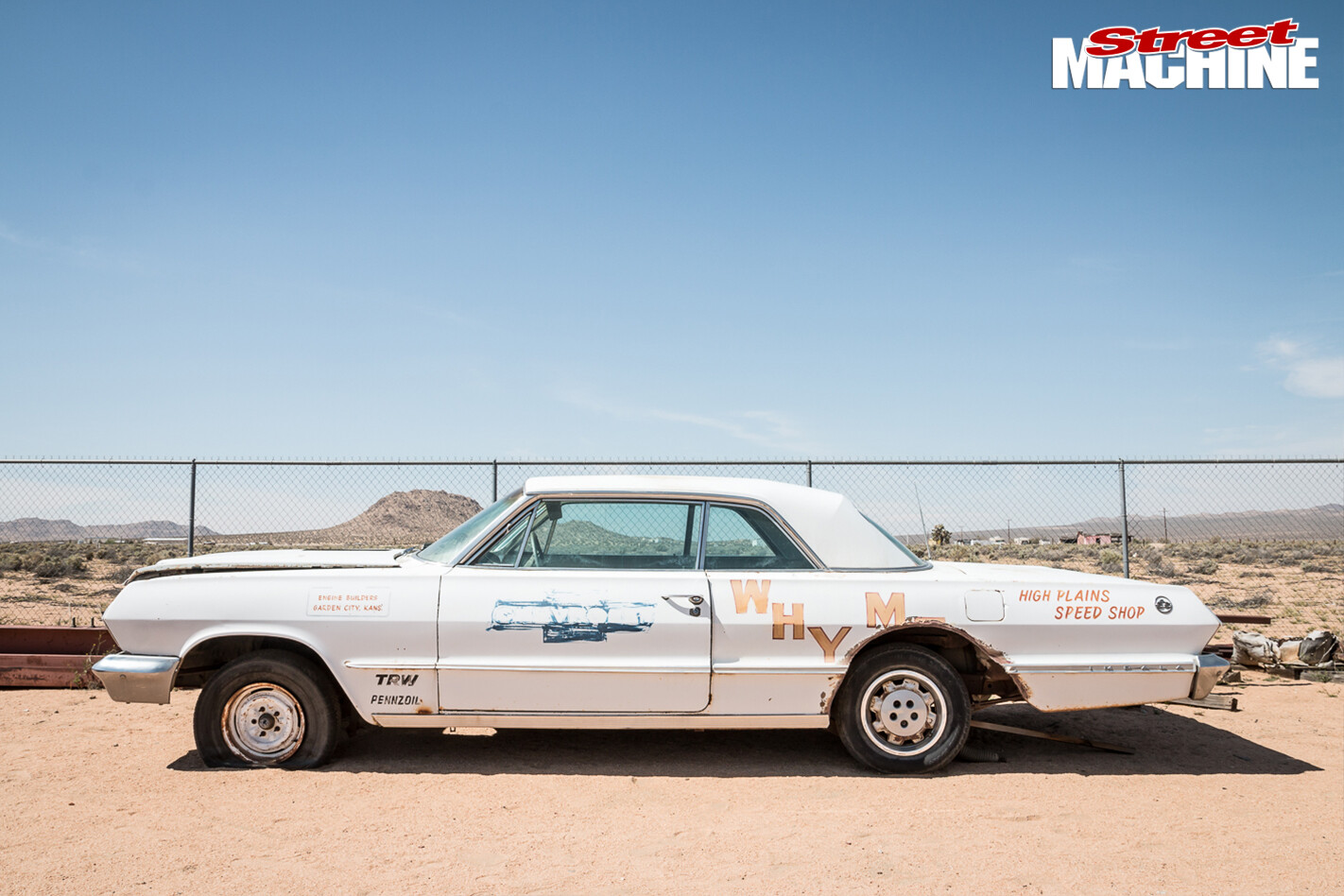 Adam points to a ’63 Impala SS, ghosted racing logos painted on its white panels. “It was an old A/FX car or something,” he explains. “Check out the radiused rear quarters. I wanted to buy it from him and thought I could snag it cheap because someone had hacked up the back, but it’s a numbers-matching 409 so, er, it wasn’t gonna go cheap.”
Adam points to a ’63 Impala SS, ghosted racing logos painted on its white panels. “It was an old A/FX car or something,” he explains. “Check out the radiused rear quarters. I wanted to buy it from him and thought I could snag it cheap because someone had hacked up the back, but it’s a numbers-matching 409 so, er, it wasn’t gonna go cheap.”
 “You’ll love this Stude,” he continues, as we walk up to a stock early-’50s Studebaker coupe. I’m not quite sure what’s so great about it, but then Adam walks straight past it and points to the one jammed in the back corner. “It’s an old race car. I don’t really know much about it, but it’s bitchin’, isn’t it?”
“You’ll love this Stude,” he continues, as we walk up to a stock early-’50s Studebaker coupe. I’m not quite sure what’s so great about it, but then Adam walks straight past it and points to the one jammed in the back corner. “It’s an old race car. I don’t really know much about it, but it’s bitchin’, isn’t it?”
I nod, wide-eyed. It’s got a heavy chop, 50 bazillion louvres and blue Plexiglass windows. The radical 60s-style paintjob, complete with metalflake, airbrushed fades, lace, silly lines – the whole works – is cracked and peeling.
 Adam picks up the hood a little to see inside. “Check out the blown Hemi. This would have been something fast.” The front clip is straight off a Corvette Stingray, and the dusty motor sits halfway between the engine bay and the cockpit, the windscreen chopped away to make room for it. “And how neat is this?” Adam exclaims. “The rear quarters hinge upwards so you could change tyres.”
Adam picks up the hood a little to see inside. “Check out the blown Hemi. This would have been something fast.” The front clip is straight off a Corvette Stingray, and the dusty motor sits halfway between the engine bay and the cockpit, the windscreen chopped away to make room for it. “And how neat is this?” Adam exclaims. “The rear quarters hinge upwards so you could change tyres.”
 We keep walking and I keep gawking. “Just behind here is the original SCTA timing tower from the lake in the 40s, if you wanna see,” Adam says. I walk past what I’m told is a numbers-matching Barracuda and around an RV to check out the timing tower. While it’s not an impressive piece of architecture in itself, its significance is more than enough to elevate it to holy artefact status.
We keep walking and I keep gawking. “Just behind here is the original SCTA timing tower from the lake in the 40s, if you wanna see,” Adam says. I walk past what I’m told is a numbers-matching Barracuda and around an RV to check out the timing tower. While it’s not an impressive piece of architecture in itself, its significance is more than enough to elevate it to holy artefact status.
 We get to the main shed and peek in through the back, where a ’33 Ford roadster sits partially dismantled, a tired Hemi with a giant turbo mounted up front. The grille shell has 200mph Club stickers on it that look like they’ve been there since the 50s. Examining the little bits of rust, welds and cobwebbed mechanicals, we wonder if it will ever see race time again.
We get to the main shed and peek in through the back, where a ’33 Ford roadster sits partially dismantled, a tired Hemi with a giant turbo mounted up front. The grille shell has 200mph Club stickers on it that look like they’ve been there since the 50s. Examining the little bits of rust, welds and cobwebbed mechanicals, we wonder if it will ever see race time again.
 Then Adam says he’s due back at the lake to help the Salty Box Racing crew with their entry for the May speed trials at El Mirage (stay tuned for a story on that epic beast!). We start to make our way back towards the car, when an old voice cries out from the other side of the shed.
Then Adam says he’s due back at the lake to help the Salty Box Racing crew with their entry for the May speed trials at El Mirage (stay tuned for a story on that epic beast!). We start to make our way back towards the car, when an old voice cries out from the other side of the shed.
“Hey Adam! Ya know it’s all for sale!”
 Adam says George reckons this Citroen DS is car #1 of the upgraded model introduced in 1969 to the American public, after its new French technological improvements were finally approved
Adam says George reckons this Citroen DS is car #1 of the upgraded model introduced in 1969 to the American public, after its new French technological improvements were finally approved
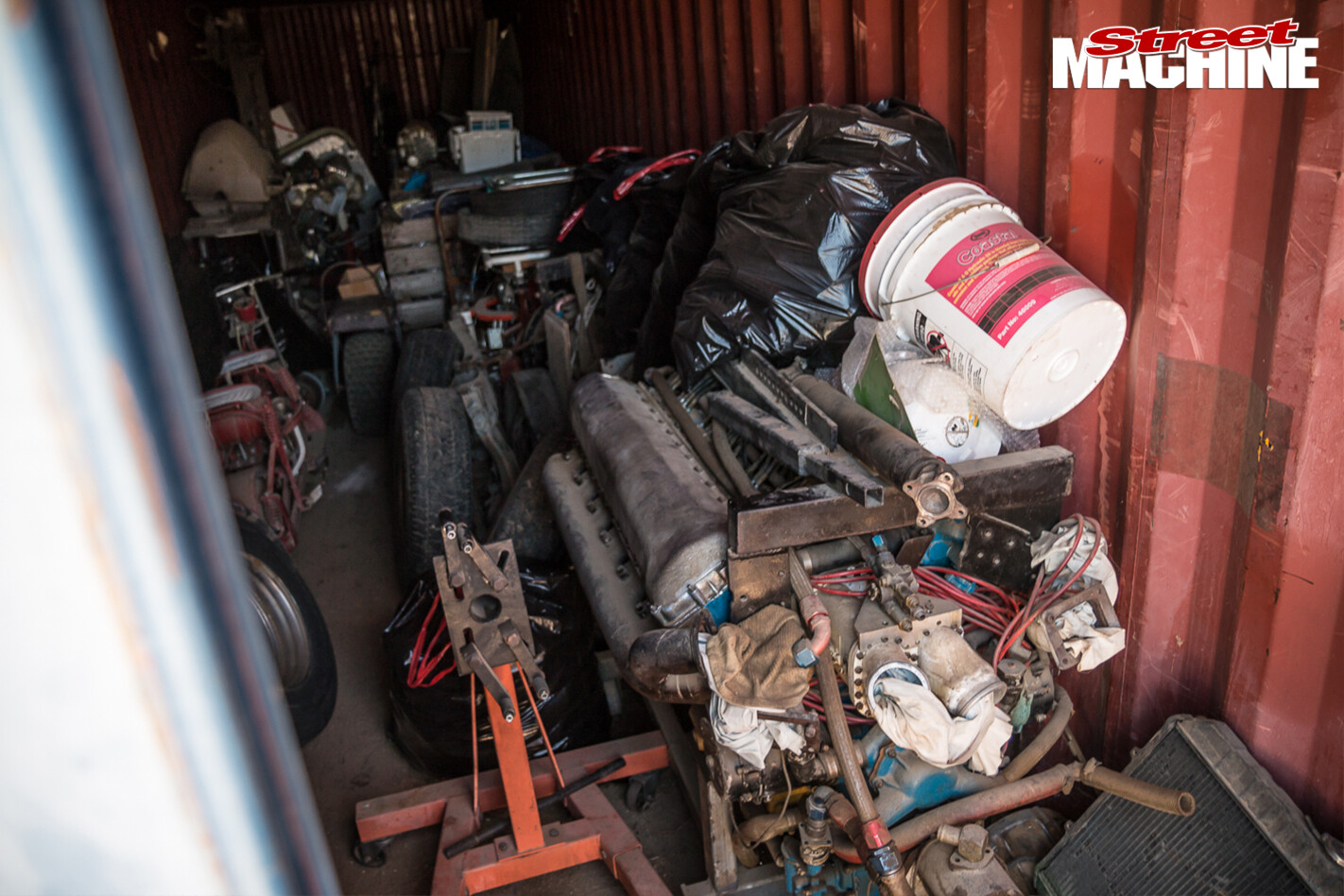 A Rolls-Royce V12 hides in a shipping container. Apparently it was intended to go in a land speed car, but nothing has yet transpired
A Rolls-Royce V12 hides in a shipping container. Apparently it was intended to go in a land speed car, but nothing has yet transpired
 One of the strangest-looking cars of 1950 was the Studebaker Champion. The central ‘spinner’ grille was a copy of Ford’s design idea, but was soon dropped
One of the strangest-looking cars of 1950 was the Studebaker Champion. The central ‘spinner’ grille was a copy of Ford’s design idea, but was soon dropped
 Imported from Ford Europe, these Capris were officially Mercurys, but weren’t badged as such. They actually sold amazingly well in a country big on large cars and V8 engines. This one looks like it was set up for racing
Imported from Ford Europe, these Capris were officially Mercurys, but weren’t badged as such. They actually sold amazingly well in a country big on large cars and V8 engines. This one looks like it was set up for racing
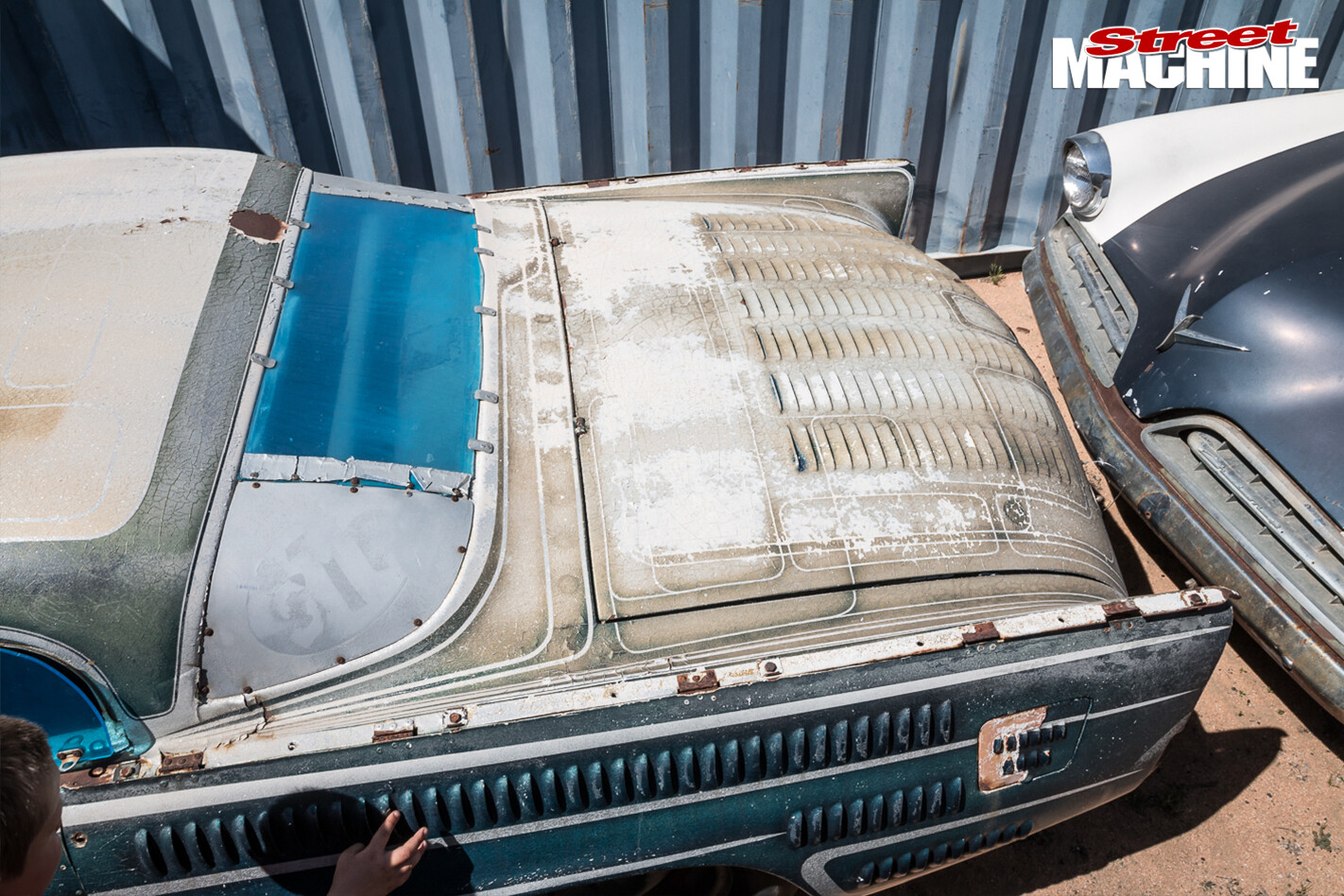 Here you can see the hinges on the rear of the Studebaker race car. To get at the rear wheels and axles, you could simply unfasten the panel and lift it up like a gullwing door.
Here you can see the hinges on the rear of the Studebaker race car. To get at the rear wheels and axles, you could simply unfasten the panel and lift it up like a gullwing door.
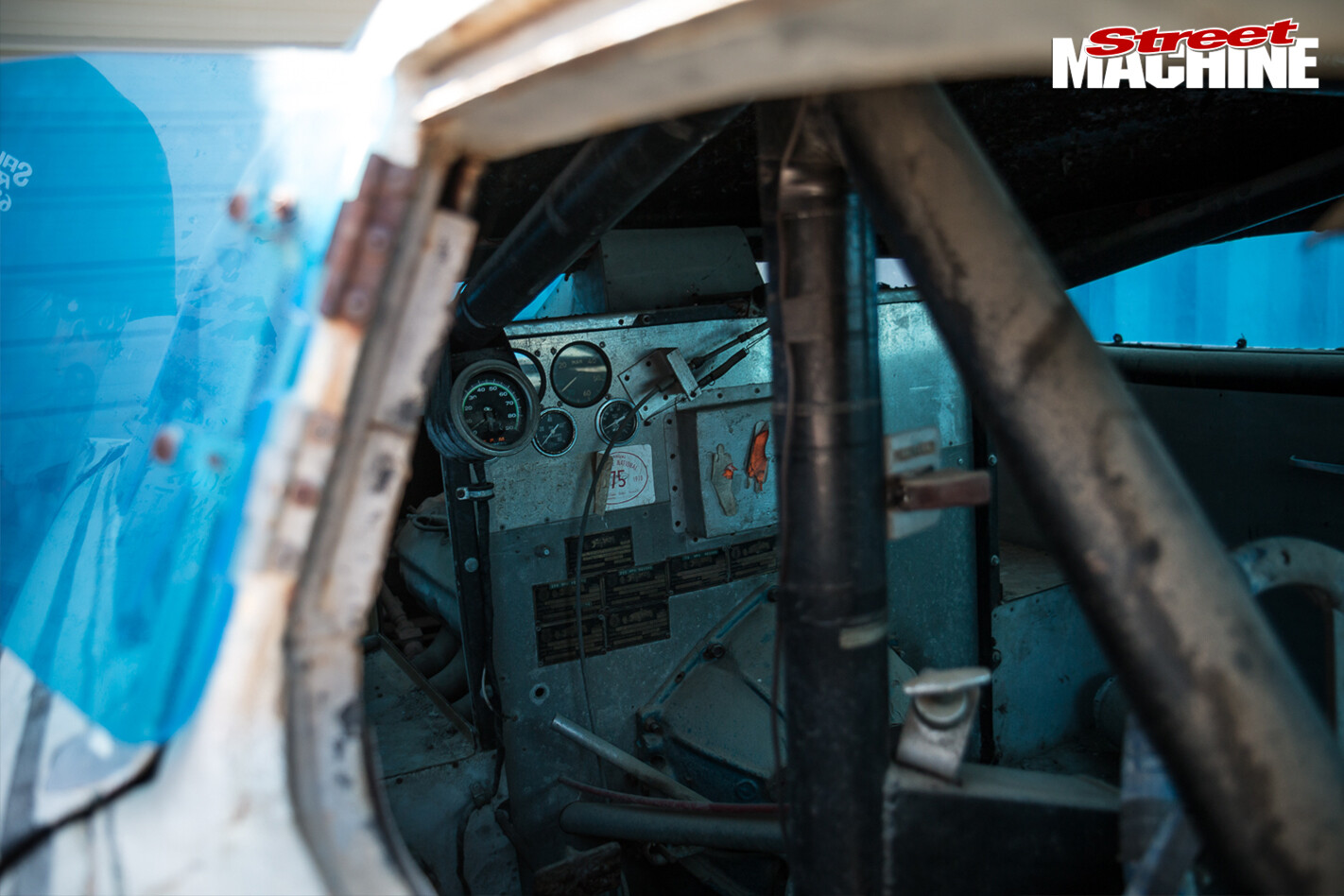 The Studebaker’s interior
The Studebaker’s interior
 The Stude has a complete Corvette Stingray front end attached to it, most likely for aerodynamic purposes
The Stude has a complete Corvette Stingray front end attached to it, most likely for aerodynamic purposes
 This heavily louvred and modified Datsun 520 pick-up was probably a stillborn land speed racer
This heavily louvred and modified Datsun 520 pick-up was probably a stillborn land speed racer
 George is still active at El Mirage racing events; his yellow Ford roadster is a mainstay on the lake bed
George is still active at El Mirage racing events; his yellow Ford roadster is a mainstay on the lake bed
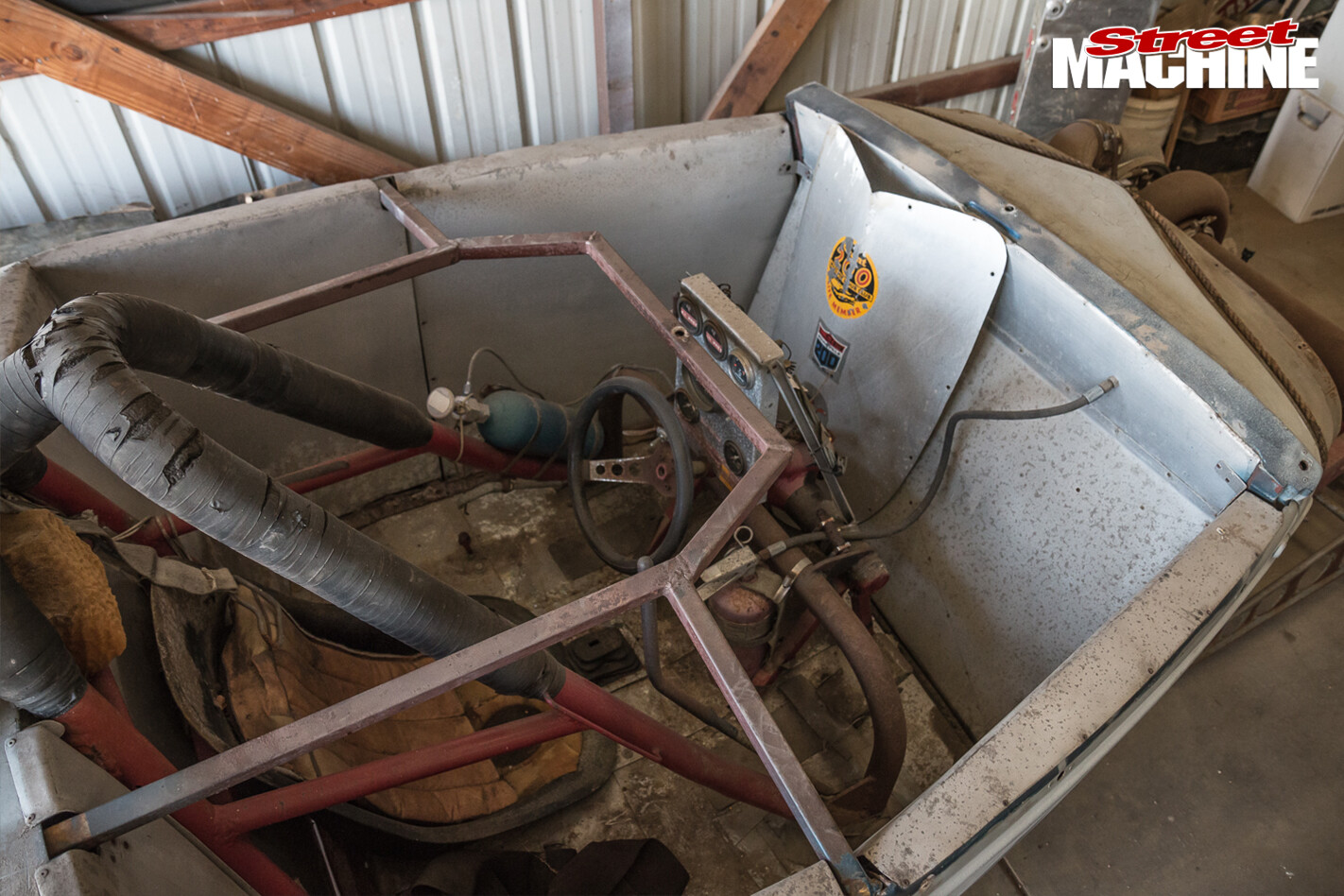 The incredibly spartan interior of George’s 200mph-club-inducted, turbo-Hemi Ford roadster
The incredibly spartan interior of George’s 200mph-club-inducted, turbo-Hemi Ford roadster
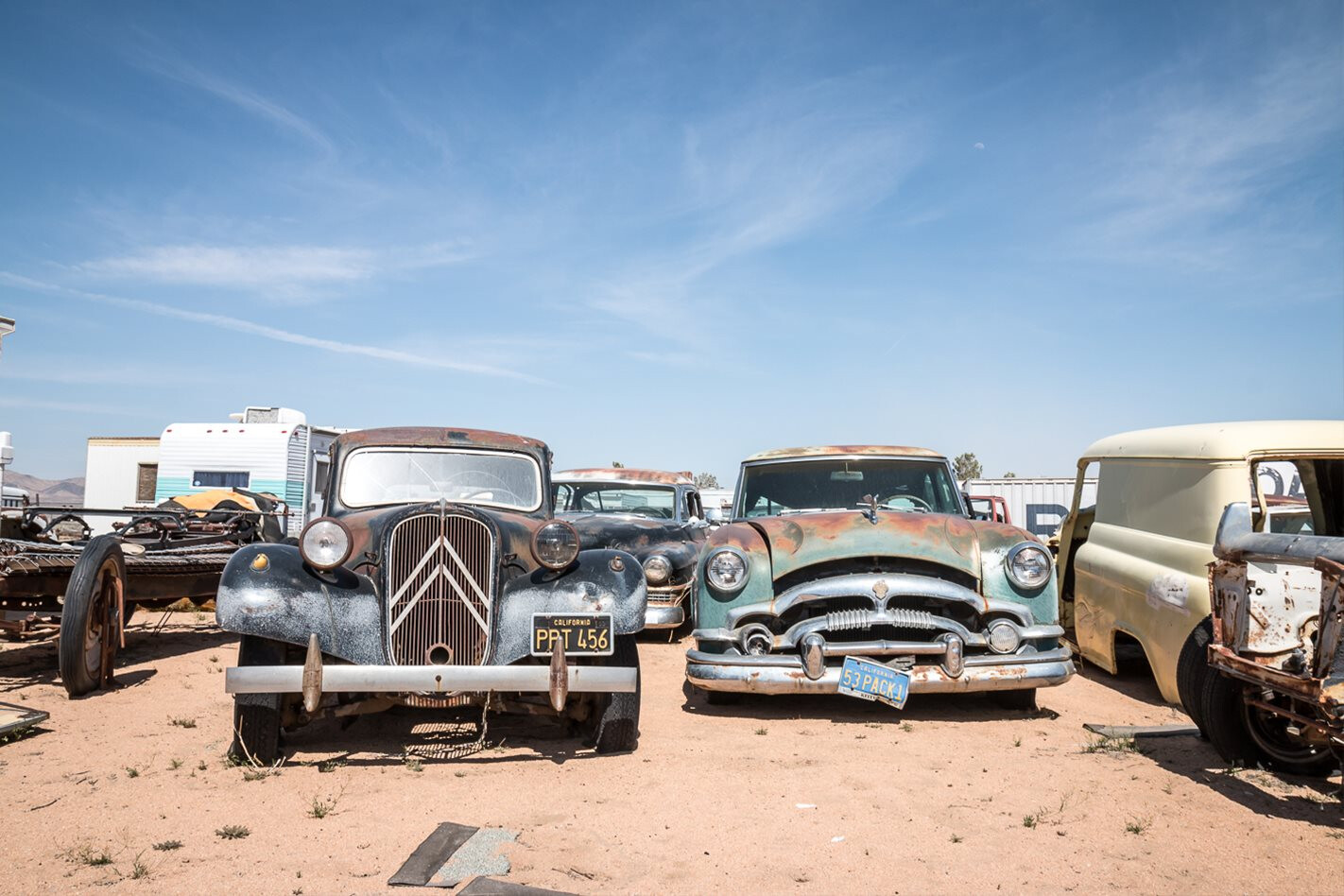



Comments